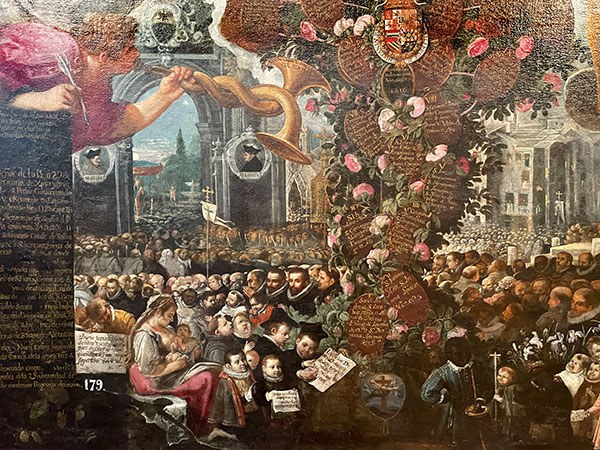Kana Fukumoto // Representing Blackness in the Art of the Spanish Empire: a Comparative Study of Works in the Imperial Court and Port Cities
From the sixteenth century onward, the Habsburg Spanish constituted a transcontinental political entity that incorporated diverse non-European populations, notably sub-Saharan Africans and Indigenous Americans, within its extensive imperial domains. My doctoral research systematically investigates the visual representation of these non-European subjects, with a particular focus on those of African descent across politically and culturally diverse territories under Spanish hegemony. By employing an interdisciplinary methodology encompassing colonial history, history of evangelization, and Black studies, among others, this research critically examines the “gaze” cast upon non-European people who either spontaneously or forcibly came to reside in European societies via the globalizing networks of the empire.
As a critical component of this dissertation, the three-month research at Zentralinstitut für Kunstgeschichte undertakes a comparative analysis of Black representation across two distinct urban typologies within the imperial network of the Spanish Monarch: courtly centers and maritime port cities. The present study analyzes a variety of visual images from sites that have been meticulously selected for their strategic value. The capital, Madrid, functioned as the metropolitan nexus of imperial power, while Naples was a crucial Mediterranean viceroyalty that exhibited distinctive economic prosperity. Mercantile centers such as Seville functioned as primary ports of entry for enslaved Africans into continental Europe. The analysis deals with a wide array of pictorial genres, including religious themes, portraiture, genre paintings, and landscapes.
 Analyzing these images with the comparative perspective will establish a productive dialectic between the politically charged representations predominant in the administrative centers of the empire and the more quotidian, genre-oriented depictions characteristic of mercantile environments. Generally speaking, in artworks created in court environments such as Madrid and Vienna tend to deploy Black African figures as rhetorical embodiments of imperial power and global dominion, while art in port cities with extensive involvement in slave trade networks including Seville, Lisbon, and Venice often integrates African subjects as essential elements within the social fabric of maritime commercial centers, often providing visual evidence that documents the social reality of African residents, the point that is otherwise largely absent from textual sources. This research project at ZI aims to develop a theoretical and conceptual framework for understanding how the visualization of racial difference operated within and across the transcontinental networks of the Spanish Empire. It aims to develop a critical framework for understanding how the visualization of ethnic difference operated within and across the vast networks of the Spanish Empire, contributing to broader scholarly discourse on the entanglement of artistic production with imperial ideologies and early modern concepts of human difference.
Analyzing these images with the comparative perspective will establish a productive dialectic between the politically charged representations predominant in the administrative centers of the empire and the more quotidian, genre-oriented depictions characteristic of mercantile environments. Generally speaking, in artworks created in court environments such as Madrid and Vienna tend to deploy Black African figures as rhetorical embodiments of imperial power and global dominion, while art in port cities with extensive involvement in slave trade networks including Seville, Lisbon, and Venice often integrates African subjects as essential elements within the social fabric of maritime commercial centers, often providing visual evidence that documents the social reality of African residents, the point that is otherwise largely absent from textual sources. This research project at ZI aims to develop a theoretical and conceptual framework for understanding how the visualization of racial difference operated within and across the transcontinental networks of the Spanish Empire. It aims to develop a critical framework for understanding how the visualization of ethnic difference operated within and across the vast networks of the Spanish Empire, contributing to broader scholarly discourse on the entanglement of artistic production with imperial ideologies and early modern concepts of human difference.
[Caption: Lower left part of, Juan de Roelas, The Allegory of the Immaculate Virgin, 1616, oil on canvas, 323.5 x 195 cm, Museo Nacional de Escultura, Valladolid; Photo: Kana Fukumoto]
